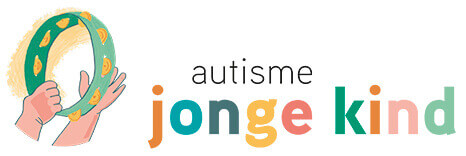
Step 3: Helping your child in daily situations
Children with autism (ASD) process information differently. This causes them to have different or unexpected reactions. How do you handle this?
Autism can manifest itself in many different ways in children. Nevertheless, there are some general tips we can provide to help you in handling your child.
Think about, for example:
- Offering structure;
- Taking your child's hyper or hypo sensitivity into account;
- Communicating clearly;
- Adjusting the pace;
- Subtitling your child's behaviour and feelings.
Offering structure
Many children with autism are, because of the ‘different’ way their brain works, flooded with information coming at them. This causes problems with filtering important information, organising information and making sense of it.
Providing structure helps your child to make the world clearer and more orderly. This can sometimes prevent frustration and anger for the child. Ways to provide structure include:
Making time clear
A planning board can help specify which activities will take place, when and in what order. First find out the way in which your child understands the planning board best. For example: should you make use of pictograms, pictures, or drawings? And: for which activities should or shouldn’t you use a picture? How detailed should you make it?
Carrying out fixed activities in fixed places
Your child wants to understand what is expected of him/her. You can help him/her with this by having fixed activities take place in fixed places. For example:
- Mealtimes always at the table
- Always reading bedtime stories in bed
- Always brushing teeth in the bathroom
Making transitions clear
A clock or alarm can help signal when an activity is over. That way, a child knows what is expected. This makes it easier for him/her to make the switch to a new activity. If you also say what will happen after this activity, you will make the transition even easier for your child. For example: When the alarm goes off, we will eat.
Tip: You can also use a time-timer for this. This is a special clock on which your child can easily see how much time he/she has left. This does not have to be in numbers, it can also be in colours.
Routines
Routines are activities that you do in a particular way. So for example, before going to bed, you first read a book and then sing a song. Routines can help your child get a grip on what’s to come. And that gives peace of mind.
For more information on providing structure, see the website of geef me de 5 (or ‘the essential 5’):
Taking your child's sensory profile into account
What is meant with a sensory profile is the way in which your child reacts to environmental stimuli. So this involves seeing, hearing, feeling, tasting, smelling, and experiencing balance and control over one's own body. For example, muscle strength. This is also known as sensory processing, or sensory integration.
Some children with autism are hypersensitive to stimuli and, for example, have great difficulty in crowded places (such as a supermarket or a party). They may also be sensitive to sounds, such as the barking of a dog or the crying of a baby.
Example trip to the supermarket:
Your child has autism and gets stressed out by a trip to the supermarket. What can you do to make it easier for your child? You can help your child deal with the stimuli and/or try to avoid certain stimuli. Below, we explain how you can do this.
- Help deal with the stimulus by:
- preparing your child for what you are going to do in the shop (which shop are you going to, how many groceries are you going to get, etcetera).
- preparing your child for what he/she can do by him/herself (e.g. pushing a trolley or sitting in your trolley).
- helping your child stay calm. For example by giving his/her favourite cuddly toy or pacifier.
- walking your child through his/her feelings when you notice he/she is getting stressed. For example: 'You don't like it, do you, when the shop is so busy'.
- Avoiding certain stimuli:
- You can stop taking your child to the supermarket with you, or just at quiet times or when you only have to get one thing.
Other children are less sensitive and actually seek out stimuli. So you can, for example, help the child who needs movement to be alert by jumping on the trampoline (together) every now and then, wrestling or cuddling.
For more information on sensory processing/integration, please refer to https://www.nssi.nl..
Communicating clearly
Children with autism often understand you more quickly if you are clear and concise in your communication. But how do you communicate clearly and concisely? Here are some tips.
Give a command instead of asking a question
When you want your child to do an assignment, give a command instead of asking a question. For example: You want your child to hang up his/her coat. So you say "Go ahead and hang up your coat" instead of "Would you like to hang up your coat?".
Deliver your message in a neutral tone
Children with autism often process information in separate pieces. They have difficulty putting information together. In addition, many children are sensitive to emotions. Therefore, it is important to deliver your message in a neutral tone.
What does this mean in practice? Your child finds it difficult to listen to what you are saying when you, for example, are using an angry voice. The 'angry voice' is then, as it were, processed separately from the message you want to convey. Your child is essentially no longer hearing what it is you want to say, and gets upset by the emotional charge.
Avoid expressions or cynicism
Sometimes children with autism understand information too literally. This may make expressions difficult for them to understand. Think, for instance, of the expression 'walk around the block'. A cynical remark can also be confusing. For example, when you say 'you did a great job', while you actually mean that your child has made a big mess of it.
Adjusting the pace
Young children and specifically children with characteristics of autism often need a lot of time to process information. The difference in pace between adults and children is, in any case, very large. Try to slow down your pace and build in "puzzle time". These are moments in which your child can take some time to think about what you mean.
How can you tell if your child is processing information more slowly?
- Your child regularly does not respond to a question or request. A little while later, you notice that he/she has in fact heard you.
- Your child immediately reacts dismissively to your question or request. 'No' in this case means 'I need time to process this'.
Subtitling your child's behaviour and feelings
By articulating behaviour and feelings for your child, you can help your child get a better grip on his/her behaviour and feelings. How do you do this?
For example: you arrive at the petting zoo with your child. You can see that your child gets upset because there are many unfamiliar children. You then name his/her reaction: 'That is a bit of a shock. A bunch of new children'. Then you give your child time to process this: 'Let's play on the swing first, so you can get used to it'.
Step 4: Enlisting (professional) help


